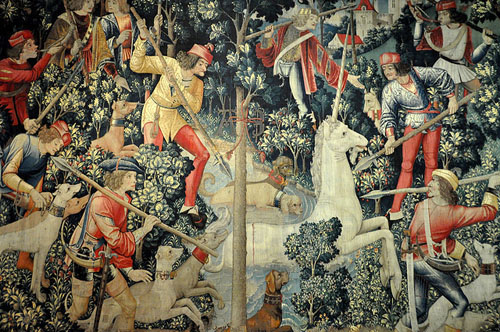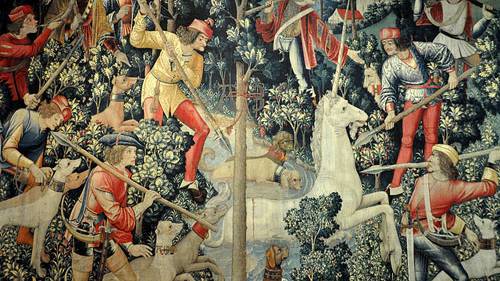Mysterious 500-year-old tapestries depict a unicorn hunt
Source: atlasobscura.com

Comprised of seven wall hangings, each at least 12 feet high by 8 feet wide, the Unicorn Tapestries at the Cloisters were created 500 years ago by an unknown artist for unknown royalty in Western Europe.
In violent and disturbing detail, the series tells the story of hunters stalking through the woods with their canines, hunting the mythical beast. As the story progresses, the unicorn is found and surrounded, ambushed and eventually attacked from all sides. Despite getting away from the hunters, the unicorn is eventually calmed by a virgin maiden and killed while under her charm.
Most people who have studied the tapestries believe they come from 1495-1505, from somewhere in southern Holland. Although even those details are often debated. Despite a general geographic location, the identity of the author is completely unknown. The tapestries’ only connection to the past is a small cipher, showing the letters A and B intertwined by some rope, which may signify the artist or the owner of the work.
From this slight hint, some have devised that Anne of Brittany commissioned the works to celebrate her marriage to Louis XII, but there is no conclusive proof and the code of the Unicorn Tapestries remains unbroken. Despite the mystery, art historians have reveled in the chance to interpret the tapestries, often comparing the hunt of the unicorn to the Passion of Christ. The unicorn itself, once a pagan symbol, became a symbol for Christ.
[...]
Read the full article at: atlasobscura.com
Unicorns in Antiquity
The unicorn is a legendary animal that has been described since antiquity as a beast with a large, pointed, spiraling horn projecting from its forehead. The unicorn was depicted in ancient seals of the Indus Valley Civilization and was mentioned by the ancient Greeks in accounts of natural history by various writers, including Ctesias, Strabo, Pliny the Younger, and Aelian. The Bible also describes an animal, the re’em, which some translations have rendered with the word unicorn.
In European folklore, the unicorn is often depicted as a white horselike or goatlike animal with a long horn and cloven hooves (sometimes a goat’s beard). In the Middle Ages and Renaissance, it was commonly described as an extremely wild woodland creature, a symbol of purity and grace, which could only be captured by a virgin. In the encyclopedias its horn was said to have the power to render poisoned water potable and to heal sickness. In medieval and Renaissance times, the horn of the narwhal was sometimes sold as unicorn horn.






















